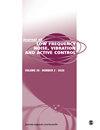处理电锤传递振动:不同钻头现场测量的频率和震级调查
IF 2.4
4区 工程技术
Q1 ACOUSTICS
Journal of Low Frequency Noise Vibration and Active Control
Pub Date : 2023-07-06
DOI:10.1177/14613484231186769
引用次数: 0
摘要
在电动工具中使用拆除锤是这些工具的操作员最具挑战性的工作任务之一,它使用户暴露在高水平的手传振动中。本研究的重点是寻找传递到手柄的振动水平,工具传递的频率内容,以及在控制的操作条件下,在现场典型的混凝土板上使用传统拆除锤使用不同尖端形状和长度的插入钻头的效果。安装了两个把手的三把拆除锤(重量在14到27公斤之间)根据ISO 5349作为现场测量技术进行了同时测量。研究结果表明,即使纵轴占主导地位,几个样本也会产生等效的x轴结果。所使用的工具的冲击能量和传递到刀柄的振动之间的相关性不显著。厚度为15 cm的板材的平均值均高于厚度为10 cm的板材。两种形式的平面钻头和尖尖钻头的总结果平均值分别为16.85和15.86 m/s2,在相同操作因子的样品中,差异均大于3 m/s2 (p < .03)。使用60厘米钻头的工具产生的频率加权均方根加速度(频率加权均方根加速度)大于使用40厘米钻头的工具,无论是总结果的平均值还是每个锤子的平均结果。在相同因素下,样本间平均比特长度组的差异达到4.65 m/s2 (p = 0.02)。在厚度为15 cm的混凝土板中,对长度为60 cm的平面钻头和点状钻头进行频率分析,结果表明,点状钻头在较低频率处检测到主导频率。这种差异几乎是1/3倍频带的两个频率部分。本文章由计算机程序翻译,如有差异,请以英文原文为准。
Handle transmitted vibration of electrical demolition hammers: Frequency and magnitude investigation in field measurements from different bits
Using a demolition hammer among the power tools is one of the most challenging job tasks for the operators of these tools, which exposes users to high levels of hand-transmitted vibrations. The focus of this study was for finding the vibration levels transmitted to the handles, the frequency content transmitted by the tool, and the effect of using insert bits with different tip shapes and lengths using conventional demolition hammers under controlled operating conditions on typical concrete slabs in the field. Three demolition hammers (weighing between 14 and 27 kg) with two handles installed were subjected to simultaneous measurements based on ISO 5349 as the field measurement technique. The findings demonstrated that even while the vertical axis dominated, several samples also produced equivalent x-axis results. The impact energy of the tools employed and the transmitted vibration to the tool handles are not significantly correlated with each other. All mean values were higher in the slabs with a thickness of 15 than those with 10 cm. The mean values of the total results for the two forms of flat and point tip inserted bits were 16.85 and 15.86 m/s2, respectively, and in the samples with the same operating factors, this difference was more than 3 m/s2 ( p < .03). The a wrms ( frequency-weighted root mean square acceleration) produced at tools using 60 cm bits were more than those with a length of 40 cm, both for the average of the total results and the average of the results of each hammer. The difference between the average bit length groups over samples with the same factors reached 4.65 m/s2 ( p = .02). Frequency analysis for the flat and point insert bits with 60 cm length in the concrete slabs with a thickness of 15 cm showed that the dominant frequencies detected at lower frequencies for point bits. This difference is almost two frequency parts of 1/3 octave band.
求助全文
通过发布文献求助,成功后即可免费获取论文全文。
去求助
来源期刊

Journal of Low Frequency Noise Vibration and Active Control
Engineering-Mechanical Engineering
CiteScore
4.90
自引率
4.30%
发文量
98
审稿时长
15 weeks
期刊介绍:
Journal of Low Frequency Noise, Vibration & Active Control is a peer-reviewed, open access journal, bringing together material which otherwise would be scattered. The journal is the cornerstone of the creation of a unified corpus of knowledge on the subject.
 求助内容:
求助内容: 应助结果提醒方式:
应助结果提醒方式:


